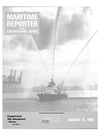
Navy Awards Bell Aerospace Textron $27.3-Million Contract For New Minesweeper Hunter
Bell Aerospace Textron, Division of Textron, Inc., has been awarded a $27.3-million contract for detail design and construction of the first Minesweeper Hunter (MSH) for the U.S. Navy. The contract also provides the Navy with two additional options to acquire eight more MSHs at a cost of $126.6 million dollars.
The additional ships would be awarded in groups of four in 1985 and 1986.^ The MSH will be a new class of coastal minesweeper designed to ensure that access to U.S. ports and coastal waterways is maintained in the event of a mine attack.
The MSH will use a surface effect ship (SES) design in which the vessel will ride on a cushion of air. This design represents a new concept for minesweepers, which in the past have used conventional displacement hulls. Final design of the MSH will be conducted at the New Orleans Operations of Bell Aerospace and the lead ship will be constructed at its Bell Halter Inc. shipyard in eastern New Orleans. The MSH lead ship is scheduled for delivery in 1987.
Award of the MSH contract was announced recently by John J.
Kelly, senior vice president and general manager of Bell Aerospace Textron, Division of Textron Inc., New Orleans Operations, and president of Bell Halter Inc. This competitive contract was won through a process that involved 17 companies and three years of intensive international competition, with Bell having offered the superior technical and most cost effective design. The MSH program is the second major Navy project won by Bell New Orleans in recent years. The company is currently building high-speed amphibious air cushion landing craft, known as LCACs (Landing Craft, Air Cushion), for U.S. Navy/Marine Corps missions. The first LCAC rolled off the Bell Halter assembly line in May 1984.
The Bell MSH design uses an air cushion to reduce the contact of the hull with the water surface, thus making the ship less susceptible to underwater shock from mine explosions.
The air cushion also reduces the underwater acoustic, magnetic, and pressure signatures of the ship, making it less likely that today's sophisticated mines will be triggered before they can be detected and neutralized by systems carried aboard the MSH. This concept offers a dramatic improvement, reducing the risk and cost of minesweeping.
To prove the effectiveness of the SES design in resisting underwater shock, Bell conducted a series of underwater explosion tests on a Bell-designed 110-foot commercial SES. During the tests, explosive charges equivalent to 1,800 pounds of TNT were detonated at various distances to the ship. After the most severe test on cushion, the SES immediately departed the area with all systems operating. The tests, conducted in February and Marcb 1984 in the Gulf of Mexico near Bell's facility in Panama City, Fla., provided the first data proving the superior shock resistance of the SES desigr A leader in the advanced Marine vehicle field, Bell Aerospace has pioneered air cushion vehicle (ACV) and SES technology during the last 20 years. John Kelly has been instrumental in the development of air supported ships for almost two decades. He has led the successful development and introduction of the LCAC (Landing Craft, Air Cushion) which is the basis for the modernization of the U.S. Navy amphibious landing forces, and most recently the technological breakthrough leading to the Navy's selection of an air supported MSH. Bell designs are built at the Bell Halter shipyard, a company owned by Bell Aerospace Textron and Halter Marine, Inc.
Read Navy Awards Bell Aerospace Textron $27.3-Million Contract For New Minesweeper Hunter in Pdf, Flash or Html5 edition of January 15, 1985 Maritime Reporter
Other stories from January 15, 1985 issue
Content
- Call For Papers Issued By SNAME New England For Computer Symposium page: 4
- Couch Named President Of Matson Navigation— Wasacz President Of A&B page: 5
- SecNav Lehman Announces Contract Awards Totaling Almost $2 Billion page: 5
- Hyde Names Two New Vice Presidents page: 6
- Another Fast Delaware Pilots Boat Delivered By Gladding-Hearn Yard page: 6
- Hyundai To Build Four Rigs For ODECO At Total Cost Of $260 Million page: 7
- RDI Announces $15-Million Agreement With China For Electronic Shipping Safety Systems page: 7
- Newport News Shipbuilding Delivers Attack Submarine 'Olympia' page: 8
- Fifth Generation Of Family Named To Executive Posts At Hughes Companies page: 8
- Butterworth Announces A New SCAMP Underwater Hull Cleaning Station page: 8
- New Chief Seattle Fireboat Provides High-Speed Response page: 10
- New York Port Engineers' Society Tours MarineSafety Simulators page: 11
- Todd Awarded $30 Million By Navy To Modify First Aviation Support Vessel page: 11
- COMPUTERIZED VESSEL MANAGEMENT SYSTEMS page: 14
- Ingram Purchases Assets Of Ohio Barge Line And Mon-Valley Transportation page: 22
- Marconi Introduces The New Oceanray SAT-COM page: 22
- Bay-Houston Towing Offers 'Port Reference Handbook' For Six Gulf Ports page: 23
- Eisert Named To Head General Electric's New Navy Programs Section page: 26
- Daewoo To Build Tanker For Norwegian Company For $40 Million page: 26
- Tracor Marine Awarded $2.5-Million MSC Contract To Operate Research Ship page: 28
- Navy Awards Bell Aerospace Textron $27.3-Million Contract For New Minesweeper Hunter page: 28
- Gerard M. McAllister 1910-1984 page: 29
- Diesel Engine Manufacturers Continue To Improve The Fuel Efficiency Of Their Engines page: 30
- Sea Data Corporation Introduces Deep Sea Instrumentation Cable page: 46
- Kastalon Offers New Brochure On Polyurethane Crane Bumpers page: 47
- Goodway Offers New Catalog On Tube Cleaning Systems And Pressure Washers page: 47


